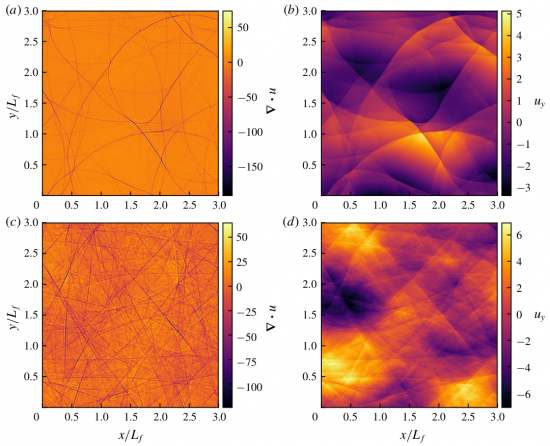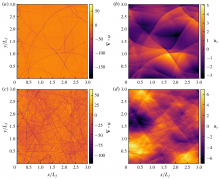The dynamics of irrotational shallow water wave turbulence forced in large scales and dissipated at small scales is investigated. First, we derive the shallow water analogue of the `four-fifths law’ of Kolmogorov turbulence for a third order structure function involving velocity and displacement increments.

Using this relation and assuming that the flow is dominated by shocks we develop a simple model predicting that the shock amplitude scales as $(\epsilon d)^1/3$, where $\epsilon$ is the mean dissipation rate and $d$ the mean distance between the shocks, and that the $p$:th order displacement and velocity structure functions scale as $(\epsilon d)^p/3 r/d$, where $r$ is the separation. Then we carry out a series of forced simulations with resolutions up to $7680^2$, varying the Froude number, $F_f = \epsilon^1/3 / ck_f^1/3$, where $k_f$ is the forcing wave number and $c$ is the wave speed. In all simulations a stationary state is reached in which there is a constant spectral energy flux and equipartition between kinetic and potential energy in the constant flux range. The third order structure function relation is satisfied with a high degree of accuracy. Mean energy is found to scale as $E \sim \sqrt\epsilon c/k_f$, and is also dependent on resolution, indicating that shallow water wave turbulence does not fit into the paradigm of a Richardson-Kolmogorov cascade. In all simulations shocks develop, displayed as long thin bands of negative divergence in flow visualisations. The mean distance between the shocks is found to scale as $d \sim F_f^1/2/k_f$.
Structure functions of second and higher order are found to scale in good agreement with the model. We conclude that in the weak limit, $F_f \rightarrow 0$, shocks will become denser and weaker and finally disappear for a finite Reynolds number. On the other hand, for a given $F_f$, no matter how small, shocks will prevail if the Reynolds number is sufficiently large.
Pierre Augier, Ashwin Vishnu Mohanan, and Erik Lindborg. Shallow water wave turbulence. J. Fluid Mech., 874:1169–1196, 2019. doi:10.1017/jfm.2019.375.
Members :
![]() Ashwin VISHNU MOHANAN - KTH
Ashwin VISHNU MOHANAN - KTH
![]() Erik LINDBORG - KTH
Erik LINDBORG - KTH
![]() Pierre AUGIER
Pierre AUGIER - LEGI Grenoble





